Podcast: Play in new window | Download | Embed
Subscribe: Apple Podcasts | Spotify | Amazon Music | Email | TuneIn | RSS | More
An hour-long conversation with Julie Czerneda ( bestselling author of The Clan Chronicles books and many, many others) about her creative process, with a special focus on her upcoming fantasy The Gossamer Mage.
The Introduction:
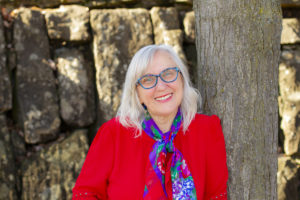 Julie Czerneda was born in Exeter, Ontario, and grew up on air force bases, her family moving with each transfer, from Ontario to Prince Edward Island and finally to Nova Scotia. When her father became a civilian, the family moved to Ontario, settling in what was then a rural setting near the shores of Lake Ontario (and is now that not-so-rural setting known as Mississauga.
Julie Czerneda was born in Exeter, Ontario, and grew up on air force bases, her family moving with each transfer, from Ontario to Prince Edward Island and finally to Nova Scotia. When her father became a civilian, the family moved to Ontario, settling in what was then a rural setting near the shores of Lake Ontario (and is now that not-so-rural setting known as Mississauga.
Julie studied biology at the Universities of Waterloo, Saskatchewan, and Queen’s, accompanied by her former chemistry partner (and now husband) Roger. They moved a few times before settling back in Ontario, where they still live.
Julie began her writing career in educational publishing, beginning when she was on maternity leave from a university teaching. She became a full-time author and editor of non-fiction educational materials, primarily in science, in 1985, contributing to more than 250 titles from elementary to college level. But she also had twenty-three unpublished and unfinished science fiction novels tucked away in file folders, and with encouragement from husband, she finished the one in file folder X, Beholder’s Eye, which was bought by DAW Books. That same year, Julie was a finalist for the John W. Campbell Award for Best New Writer, and DAW contracted for three more novels.
She’s been published by DAW ever since: eighteen novels, including the popular nine-book The Clan Chronicles series. She’s also written many short stories, edited anthologies, and taught writing. Her books have received international acclaim, multiple awards, and best-selling status.
Website: czerneda.com
Twitter: @JulieCzerneda
The Show:
She says her parents conspired to make her a writer. Her father brought home the first two Tarzan books, but only gave her the first one, which “doesn’t end well.” She came running out of her room, yelling, she was so furious, and “instead of explaining to me what a cliff-hanger was, my Mom lent me her typewriter and said, ‘Fix it.’” Julie proceeded to write a page that satisfied her much more than the book, and never stopped. She wrote so much as a child her parents bought her a file cabinet to hold it all.
We discussed whether moving from place to place as a child of a military family influenced her writing; Julie said only in that, when they left the Air force and moved into a civilian neighbourhood, all the other kids had gone off to summer cottages. That left her alone and exited to have time to write.
She encountered new science fiction for the first time in her university bookstore. “To be able to buy them myself was liberating.”
Julie studied biology. She feels her interest in science and her interest in science fiction arise from the same place. “It seemed like a lot things I read as a kid were finite. They just ended, or they were real life, and while real life is marvellous, I’d rather talk to real people about it. So, when I discovered things that were showing me something beyond what was here, it was the same itch being scratched that takes me into science.” She said she went into science because she wanted to explore how the world works, and read science fiction because she wanted new, interesting ways of thinking about the world.
She originally wanted a joint degree in physics and biology, so she could be the first person to go into place equipped to communicate with aliens (a plan she wrote out in third grade). However, the University of Waterloo wasn’t set up for that, so her courses conflicted.
Much of her early fiction writing was really biological thought experiments. Asked if being a scientist makes it difficult for her to write fantasy, she notes a good fantasy novel, because it takes her out of herself, so she doesn’t worry about the real-world impossibility of it. She was herself hesitant about writing fantasy for a long time because she felt the language was so rich, and the landscapes so intense, she couldn’t see herself doing it.
However, after DAW began publishing her, she was asked to write a fantasy story for an anthology being edited by Martin H. Greenberg. “You don’t say no, so I wrote my first fantasy.”
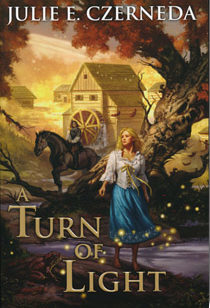 Still, the prospect of writing a fantasy novel terrified her. She finally did (A Turn of Light), but she says it took her five years to work up the courage to start, and two years (and deleting 400,000 words) to figure out how to do it.
Still, the prospect of writing a fantasy novel terrified her. She finally did (A Turn of Light), but she says it took her five years to work up the courage to start, and two years (and deleting 400,000 words) to figure out how to do it.
She notes her popular Esen character, who has an ability associated with magic in fantasy, didn’t begin as a shapeshifter—she was the result of a thought experiment, trying to figure out what would be necessary for a biological organism to be semi-immortal. The Esen books continue to be her “biological playground,” Julie says. “I have a very large filing cabinet full of weird biology and all of it goes into those books. Most of the weird stuff is real.”
Her upcoming fantasy, The Gossamer Mage, grew out of a fantasy novella Eric Flint asked her to write. She was inspired by a pen in the Lee Valley catalogue, which included words for parts of a pen she’d never heard before. She did some more research, and realized she wanted to write a magic system based on pen and ink. She clipped the image from the catalogue, and that, in turn, gave her the main character, because the story opens with the pen in his hand after many years of use. (She also researched the history of ink, “which is full of great drama and crime and all manner of skullduggery. It’s amazing!”)
Julie says her research differs from science fiction to fantasy and gives some examples.
Whereas when she’s writing science fiction, Julie says, she tends to know enough about the question she wants to ask to get going and what she additionally needs to research. (For example, for something she won’t be writing for a couple of years, she’s currently researching plate tectonics.)
For fantasy, her research focuses mostly on the worldbuilding, “because everything past the worldbuilding is me, making it up.”
She likes to physically visit places: in A Turn of Light there are a lot of log cabins, so she spent a lot of time in cabins. She also went to a running mill, so she could feel how the building shakes and moves.
The amount of outlining Julie does depends on the book. She did little for A Turn of Light, wanting to see where it went. For the next two Esen books, she’s made a note of their shape and the major plot threads. The Gossamer Mage is quite different: it’s a series of novellas, each of which moves the story forward, but which can be read separately or in a different order. She’s outlining those more tightly. Usually she doesn’t outline a book until she’s almost finished, so she can go back and make sure she’s covered every point—more to check herself than to plot to.
She doesn’t have much problem with continuity while writing series, she says, but she does have to work to keep the voices consistent.
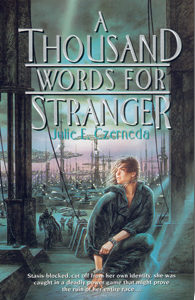 She likes to put as much as she can into a story so she can draw on it latter—such as the giant lobsteresque alien from A Thousand Words for Stranger who has a pool in his suite in which he has “carnivorous non-verbal wives.” The implication is they’re non-sentient, but Julie never intended for them to stay that way, and they became major players in the final finale trilogy. “I never knew if I would do that. I just put it in, because the more you put into a story, the richer it reads.”
She likes to put as much as she can into a story so she can draw on it latter—such as the giant lobsteresque alien from A Thousand Words for Stranger who has a pool in his suite in which he has “carnivorous non-verbal wives.” The implication is they’re non-sentient, but Julie never intended for them to stay that way, and they became major players in the final finale trilogy. “I never knew if I would do that. I just put it in, because the more you put into a story, the richer it reads.”
Julie notes her editor (and mine), Sheila E. Gilbert, told her a long time ago that she likes to have the sense the world she’s reading about continues off the page—places the main characters haven’t been, unexplored areas, things that don’t get mentioned but you know that they exist.
Julie gives a bit of a synopsis of The Gossamer Mage, with its magicians spending their life with every act of magic, sometimes just to create beautiful things. “It’s very much a case of, if you want to keep magic, what are you willing to do? And is there a value to just random beauty, or not?” She adds, “I myself don’t know how it will end.”
The two main characters are the magic user from the original novella, “Intended Words,” now the first novella in the book, who is trying to destroy the deathless goddess because he’s seen so many of his friends turn old and die for nothing, and one of the daughters who serves the goddess, who, in the second novella, “Consequential Phrases,” shows what things look like from her side.
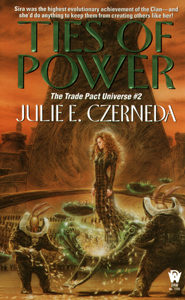 Sometimes minor characters threaten to take over a book. Julie remembers that in her second book in The Clan Chronicles, Ties of Power, the character of Simon, someone from the past of the main character who made him who he was, started to get too important. She told Sheila Gilbert she either needed to kill him off or she needed another book, and Sheila told her to go ahead and write another book, in which he got his “satisfying comeuppance.”
Sometimes minor characters threaten to take over a book. Julie remembers that in her second book in The Clan Chronicles, Ties of Power, the character of Simon, someone from the past of the main character who made him who he was, started to get too important. She told Sheila Gilbert she either needed to kill him off or she needed another book, and Sheila told her to go ahead and write another book, in which he got his “satisfying comeuppance.”
Julie does very little rewriting, possibly because she did so much non-fiction writing. “I write the best I can first time around.” After a spell-check, she sends it. Sheila comes back with requests for elaboration in certain areas, she writes that, and she’s done.
Part of that is the confidence and experience of having done this full-time for twenty years. What’s important to her is to make sure she has been “generous enough to the reader” in terms of worldbuilding, scene, and description. She’s also come to realize that any book “can only be so good.”
“I could pick up any book off the shelf that I’ve written and I’m sure I’ll find things I’d like to fix, or have someone read it to me and think, oh, that’s awkward, but if I’ve told the story I want, and at the end of it the person feels the way I meant them to feel, I still love the book, and I’m fine with that.”
Sheila Gilbert, she says, is “the ultimate beta reader,” who brings her own enormous amount of experience to the book. “For me she’s the one who’s forever slapping me on the wrist in a very calm and thoughtful way when I’ve been lazy, when I’ve left something out, when I’ve tried to skip over some important revelation…I think she’s got a wonderful instinct for the emotional content, and she’s got a great instinct for crap.”
We talked a bit about the goofs we sometimes make as writers. Julie recounts how at one point she began to confuse aft and bow on ships and would have characters go from the aft to the stern—which, of course, are the same thing. No one picked that up for years—it’s in all The Clan Chronicles books. “Everyone had missed this, and we’re talking about twenty years of proofreading. Even readers have never called me on this.”
Julie says her fiction has an optimistic bent because she doesn’t like dark, grim fiction, nor does she believe in it. “I love a really good tragedy…what I don’t like is violence used as pornography and I don’t like the victim mentality…in my experience and the way I look at the word, most people muddle along. We’re not great heroes, but we’re not great villains, either.”
She also doesn’t write grim fiction because she doesn’t want to inhabit a world like that for the long period of time it takes to write a book. “I get too engrossed in the work, and I don’t want to be there. That’s not how I want to make my living.”
The difference between writing mainstream fiction and speculative fiction, Julie says, is that when you’re writing every day, slice-of-life stories, you’re relying on your reader already being an expert on that world, which allows you to use very broad brushstrokes for most of it, only focusing in on the places you choose as your settings.
Some of that happens even in science fiction: experienced SF readers already have a mental image of a spaceship, for example, so you don’t have to describe it in detail. “I’m not shaping the world so much as pointing my flashlight at a part of it where I want their attention, as if they’re all cats and I’ve got a little pointer.” Fantasy, Julie says, requires more detailed, specific description of many of the elements of the world.
Julie thinks science fiction and fantasy writers are partly driven by dissatisfaction: “You’re not getting what you want as a reader, so you’re going to write it yourself.”
But, she adds, “I also think there are so many questions we want to answer as human beings that science fiction lets us play with, and so many things we want to say that we care deeply about that fantasy gives us a platform to say. To me, those are both very powerful draws to writing science fiction and fantasy. And I think I will always write both for that reason.”
She doesn’t write with a message in mind, except, perhaps, for, “Take care of the planet, take care of yourselves, be nice to other people.”
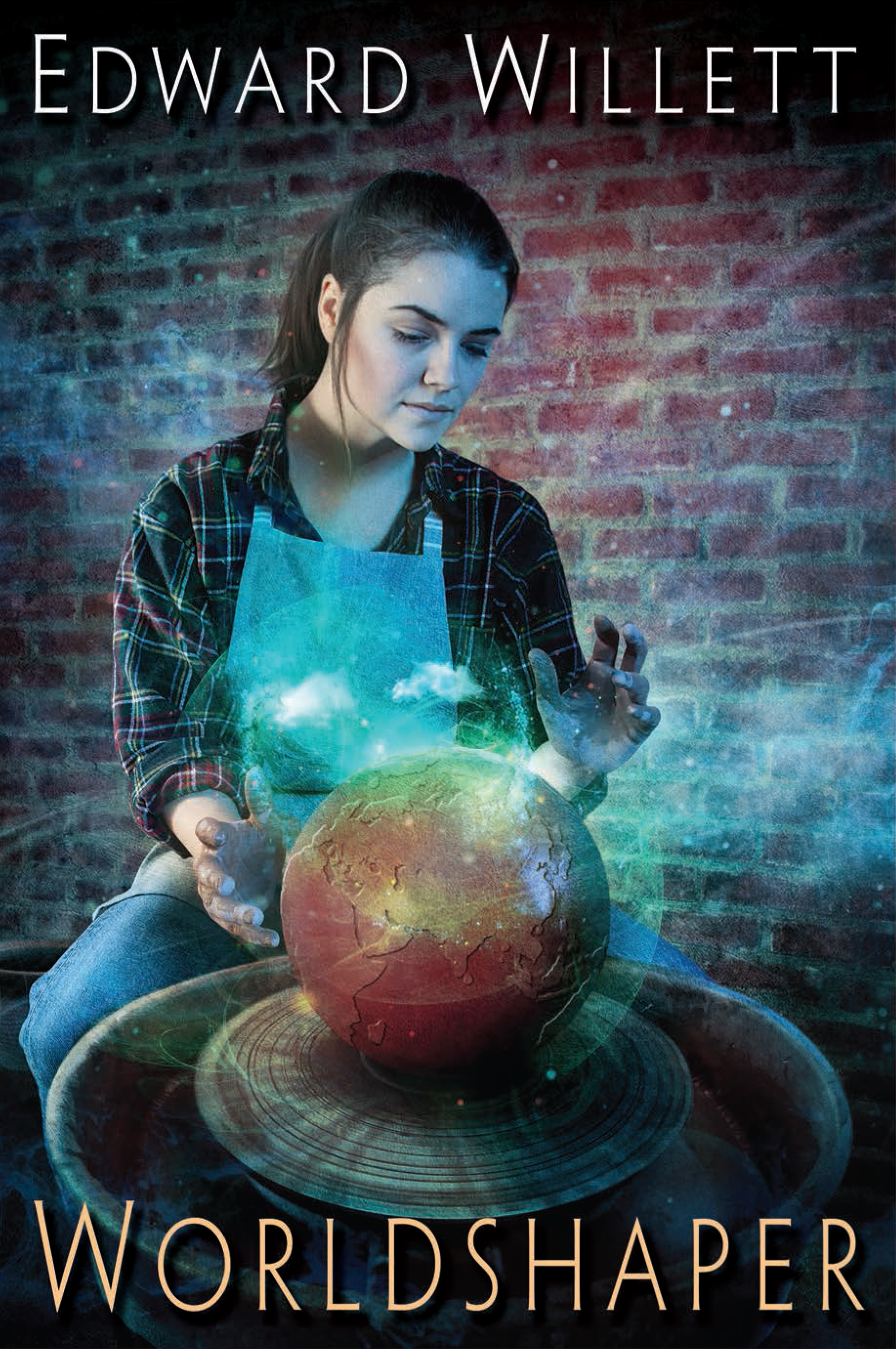
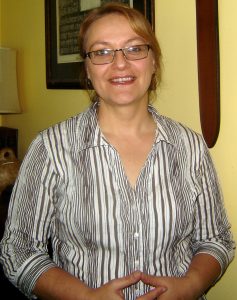
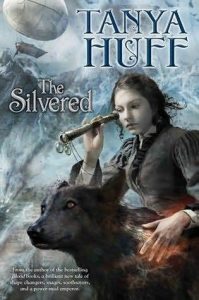 Although we’ll be discussing her book
Although we’ll be discussing her book